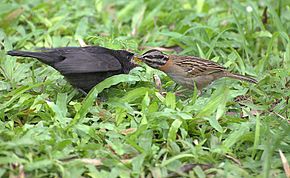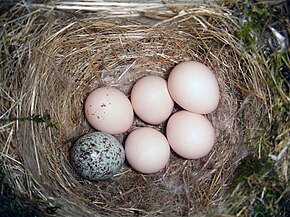Brood parasitism


Brood parasitism is a subclass of parasitism and phenomenon and behavioural pattern of certain animals, brood parasites, that rely on others to raise their young. The strategy appears among birds, insects and fish. The brood parasite manipulates a host, either of the same or of another species, to raise its young as if it were its own, usually using egg mimicry, with eggs that resemble the host's.
The evolutionary strategy relieves the parasitic parents from the investment of rearing young. This benefit comes at the cost of provoking an evolutionary arms race between parasite and host as they coevolve: many hosts have developed strong defenses against brood parasitism, such as recognizing and ejecting parasitic eggs, or abandoning parasitized nests and starting over. It is less obvious why most hosts do care for parasite nestlings, given that for example cuckoo chicks differ markedly from host chicks in size and appearance. One explanation, the mafia hypothesis, proposes that parasitic adults retaliate by destroying host nests where rejection has occurred; there is experimental evidence to support this. Intraspecific brood parasitism also occurs, as in many duck species. Here there is no visible difference between host and parasite eggs, which may be why the parasite eggs are so readily accepted. In eider ducks, the first and second eggs in a nest are especially subject to predation, perhaps explaining why they are often laid in another eider nest.
Evolutionary strategy
Brood parasitism is an
Adaptations for parasitism
Among specialist avian brood parasites, mimetic eggs are a nearly universal
The eggshells of brood parasites are often thicker than those of the hosts. For example, two studies of cuckoos parasiting great reed warblers reported thickness ratios of 1.02 : 0.87[4] and 1.04 : 0.81.[5] The function of this thick eggshell is debated. One hypothesis, the puncture resistance hypothesis, states that the thicker eggshells serve to prevent hosts from breaking the eggshell, thus killing the embryo inside. This is supported by a study in which marsh warblers damaged their own eggs more often when attempting to break cuckoo eggs, but incurred less damage when trying to puncture great reed warbler eggs put in the nest by researchers. Another hypothesis is the laying damage hypothesis, which postulates that the eggshells are adapted to damage the eggs of the host when the former is being laid, and prevent the parasite's eggs from being damaged when the host lays its eggs.[6] In support of this hypothesis, eggs of the shiny cowbird parasitizing the house wren and the chalk-browed mockingbird and the brown-headed cowbird parasitizing the house wren and the red-winged blackbird damaged the host's eggs when dropped, and sustained little damage when host eggs were dropped on them.[7]
Most avian brood parasites have very short egg
Evolutionary arms race
Bird parasites mitigate the risk of egg loss by distributing eggs amongst a number of different hosts.[9] As such behaviours damage the host, they often result in an evolutionary arms race between parasite and host as they coevolve.[10][11] Some host species have strong rejection defenses, forcing the parasitic species to evolve excellent mimicry. In other species, hosts do not defend against parasites, and the parasitic mimicry is poor.[12]
Intraspecific brood parasitism among coots significantly increases the reproductive fitness of the parasite, but only about half of the eggs laid parasitically in other coot nests survive. This implies that coots have somewhat effective anti-parasitism strategies.[13] Similarly, the parasitic offspring of bearded reedlings, compared to offspring in non-parasitic nests, tend to develop much more slowly and often do not reach full maturity.[14]
Given that the cost to the host of egg removal by the parasite is unrecoverable, the best strategy for hosts is to avoid parasitism in the first place. This can take several forms, including selecting nest sites which are difficult to parasitize, starting incubation early so they are already sitting on the nests when parasites visit them early in the morning, and aggressively defending their territory.[15]
Once a parasitic egg has arrived in a host's nest, the next most optimal defense is to eject the parasitic egg. This requires the host to distinguish which eggs are not theirs, by identifying pattern differences or changes in the number of eggs.[16] Eggs may be ejected by grasping, if the host has a large enough beak, or by puncturing. When the parasitic eggs are mimetic, hosts may mistake one of their own eggs for a parasite's. A host might also damage their own eggs while trying to eject a parasite's egg.[17]
Among hosts that do not eject parasitic eggs, some abandon parasitized nests and start over again. However, at high enough parasitism frequencies, this becomes maladaptive as the new nest will most likely also be parasitized. Some host species modify their nests to exclude the parasitic egg, either by weaving over the egg or by rebuilding a new nest over the existing one. For instance, American coots may kick the parasites' eggs out, or build a new nest beside the brood nests where the parasites' chicks starve to death.[13] In the western Bonelli's warbler, a small host, small dummy parasitic eggs were always ejected, whilst with large dummy parasitic eggs, nest desertion was more frequent.[18]
Mafia hypothesis
There is a question as to why the majority of the hosts of brood parasites care for the nestlings of their parasites. Not only do these brood parasites usually differ significantly in size and appearance, but it is also highly probable that they reduce the
Similarity hypothesis
Common cuckoo females have been proposed to select hosts with similar egg characteristics to her own. The hypothesis suggests that the female monitors a population of potential hosts and chooses nests from within this group.[21] Study of museum nest collections shows a similarity between cuckoo eggs and typical eggs of the host species. A low percentage of parasitized nests were shown to contain cuckoo eggs not corresponding to the specific host egg morph. In these mismatched nests a high percent of the cuckoo eggs were shown to correlate to the egg morph of another host species with similar nesting sites. This has been pointed to as evidence for selection by similarity.[21] The hypothesis has been criticised for providing no mechanism for choosing nests, nor identifying cues by which they might be recognised.[22]
Hosts raise offspring
Sometimes hosts are completely unaware that they are caring for a bird that is not their own. This most commonly occurs because the host cannot differentiate the parasitic eggs from their own. It may also occur when hosts temporarily leave the nest after laying the eggs. The parasites lay their own eggs into these nests so their nestlings share the food provided by the host. It may occur in other situations. For example, female eiders would prefer to lay eggs in the nests with one or two existing eggs of others because the first egg is the most vulnerable to predators. The presence of others' eggs reduces the probability that a predator will attack her egg when a female leaves the nest after laying the first egg.[23]
Sometimes, the parasitic offspring kills the host nest-mates during competition for resources. For example, parasitic cowbird chicks kill the host nest-mates if food intake for each of them is low, but not if the food intake is adequate.[24]
Taxonomic range
Birds
Intraspecific

In many
Interspecific

Interspecific brood-parasites include the
Most avian brood parasites are
The
The mechanisms of host selection by female cuckoos are somewhat unclear, though several hypotheses have been suggested in attempt to explain the choice. These include genetic
Fish
Mouthbrooding parasites
A
Nest parasites
A
Insects
Kleptoparasites

There are many different types of
Kleptoparasitism in insects is not restricted to bees; several lineages of wasp including most of the Chrysididae, the cuckoo wasps, are kleptoparasites. The cuckoo wasps lay their eggs in the nests of other wasps, such as those of the potters and mud daubers.[38] Some species of beetle are kleptoparasites, as well. Meloe americanus larvae are known to enter bee nests and feed on the provisions reserved for the bee larva.[39]
True brood parasites
True brood parasitism is rare among insects. Cuckoo bumblebees (the subgenus Psithyrus) are among the few insects which, like cuckoos and cowbirds, are fed by adult hosts. Their queens kill and replace the existing queen of a colony of the host species, and then use the host workers to feed their brood.[40]
One of only four true brood-parasitic wasps is
Host insects are sometimes tricked into bringing offspring of another species into their own nests, as with the parasitic butterfly,
See also
- Broodiness
- Host-parasite mimicry
- Kleptoparasite
- Slave-making ant
Notes
- ^ Polistes sulciferuntil 2017. This note has been included for continuity relative to pre-2017 citations used in this article.
References
- .
- S2CID 86528269.
- PMID 17827098.
- S2CID 232264070.
- ^ S2CID 55241987.
- S2CID 20285834.
- .
- PMID 20880882.
- ISBN 978-0-691-01633-7.
- ISBN 978-0-19-854892-8.
- JSTOR 2097034.
- PMID 24156805.
- ^ S2CID 53188986.
- JSTOR 20799565.
- .
- S2CID 4214442.
- .
- .
- ^ PMID 28565143.
- PMID 17360549.
- ^ .
- S2CID 17818119.
- S2CID 6187623.
- S2CID 3945653.
- ^ .
- PMC 1688387.
- S2CID 86699716.
- S2CID 16923328.
- S2CID 198154320.
- PMID 21708732.
- S2CID 8732061.
- ^ S2CID 17818119.
- S2CID 25931055.
- S2CID 4330270.
- PMID 29732407.
- S2CID 54373427.
- ^ Pawelek, Jaime; Coville, Rollin. "Cuckoo Bees". University of California Berkeley. Retrieved 24 February 2015.
- ^ "Cuckoo Wasps". Western Australian Museum. Retrieved 24 February 2015.
- ^ Pinto, John. "Bionomics and Taxonomy of Meloe (Coleoptera, Meloidae), With a Classification of the New World Species". ProQuest. University of Illinois at Urbana-Champaign ProQuest Dissertations Publishing.
- PMID 15062814.
- PMID 15019524.
- .
- ^ Deslippe, Richard (2010). "Social Parasitism in Ants". Nature Education Knowledge. Retrieved 23 June 2022.
- ^ PMC 1690087.
- PMID 18842547.

